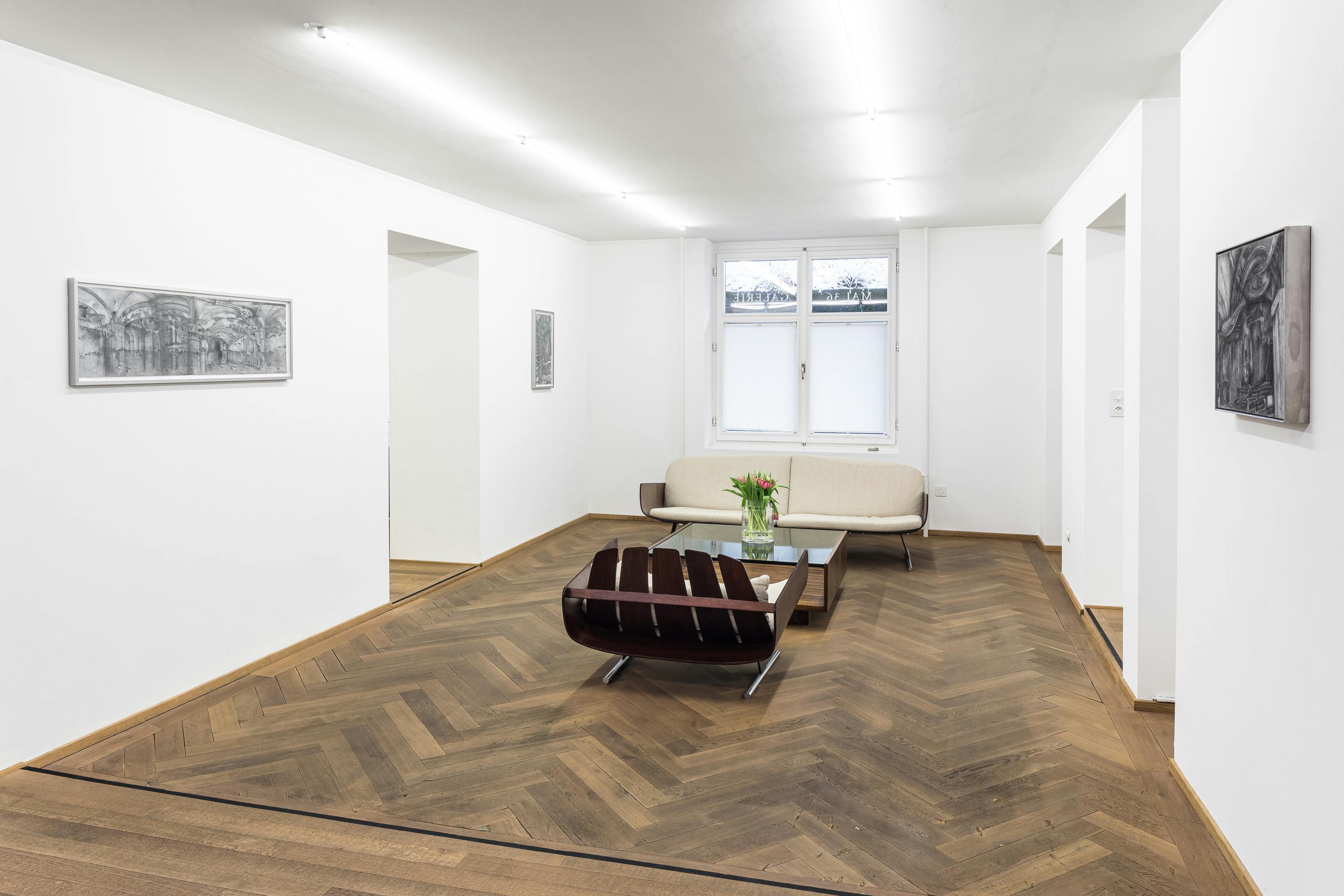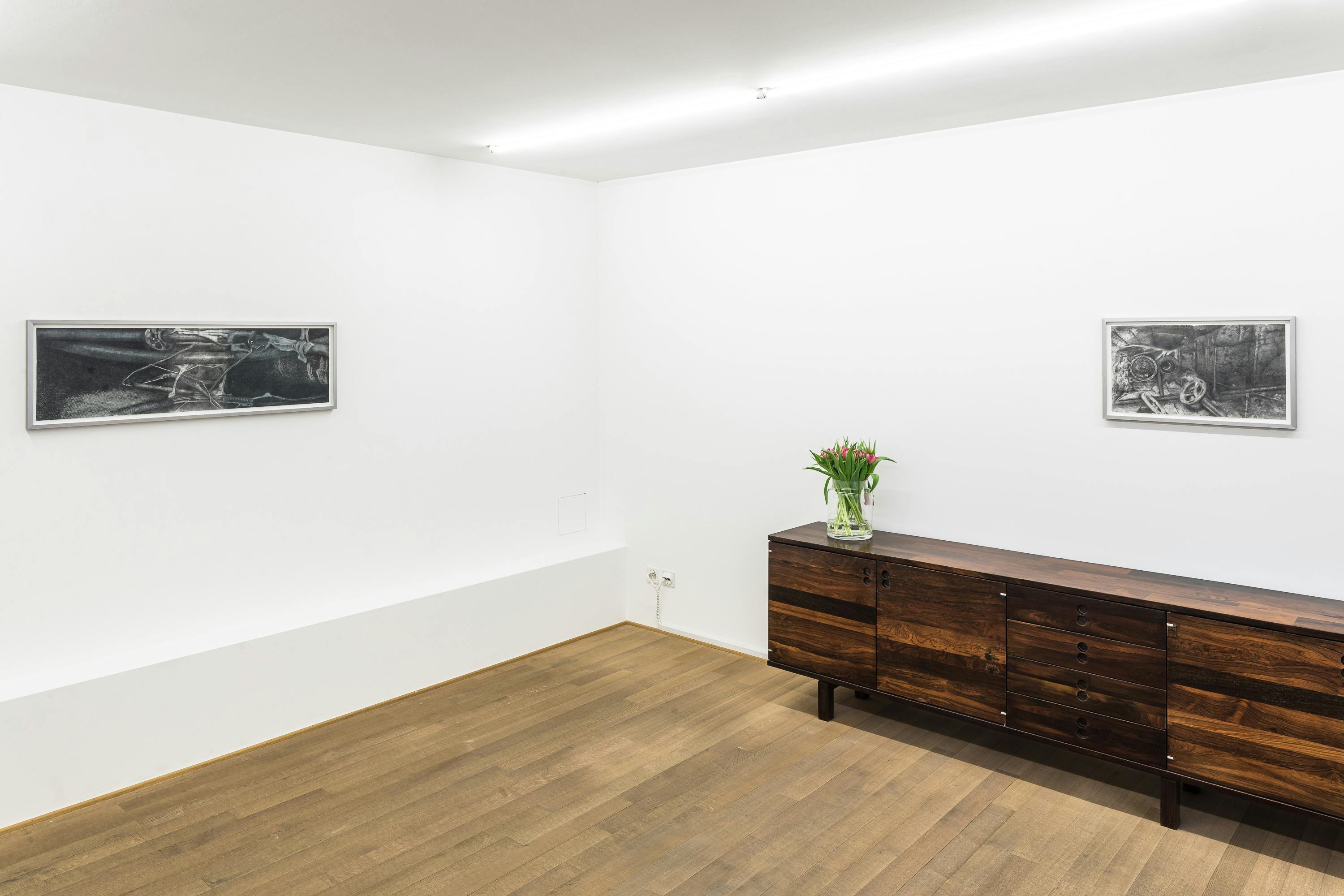Vernissage: Thursday, January 18, 2024, 6pm
Exhibition Duration: January 19 – March 09, 2024
Theory of a Body Called Staub
It is said that the refinement of the steam engine, the invention of the internal combustion engine, the harnessing of electricity, the construction of canals, railways, and electric-power lines and the imposition of mechanical clock time gave birth to what we know as the industrialisation. Lesser known is the story of a body called Staub, who came of age during the same period of time.
Staub. Her joints creak and her breathing whistles, her movements are machinic. She only knows two gears, frantically switching between complete serenity and outright frenzy. It is said she lives near a river called Saale, but there have been frequent sightings of her on the streets of Berlin and LA. She accumulates in the cracks and crevices of systems–functional and dysfunctional systems, broken control systems, water filtration systems, sewage systems, the intestinal tracts tunnelling through the underbelly of the city. On a day off, she sits on top of windowsills and covers leaves like powdered sugar. Some romanticise her as pure white snow, but oh, all the places she’s been! Three decades of use without cleaning has caused her heat sink (_) to become clogged, and she can no longer be used as she may catch fire. Her skin (=) is so tight; indeed, she is filled to bursting point with flesh and meaning. Travel down to her stomach (#) and you find a tangled chain of existence and events. As she forges her own links, her digestive tract, the locus of fear, might actually resemble, rather, a web. Synapses (*) firing, her thinking develops in the context of crises and disruption. Watch her limbs flailing, a tableau of particles chasing each other across the landscape.
Lying sideways, her mouth (o) protrudes to release whispers into the landscape. The conspiratorial lives rent-free in the corner of her eye (+), mirroring her ghostly image. As the protagonist of this story, she asserts herself as ground, not as figure. Staub is the cross winds and the tide against which kybernētēs struggles to steer his ship. She can’t be controlled. The number of activities that produce fine particles, such as sanding, crushing, conveying, mixing, drawing, cropping, rotating, zooming in and out, scatter and spit out her body over the surfaces and inside the cavities of Earth. Everywhere you go, you’ll find her sinews (–) laced in cobwebs around broken pipes and melted turn wheels. A product of history, not a natural and immutable category, she opens her form out into excess, her particle limbs exceeding her whole. Blow. (Gently.) On the horizon, you see a plume of dust erupt on the horizon like a sunrise. You realise the world would continue to turn, even with no people on it. Yet this scenario is insufferable. Flames to dust, she, the thriving, fugitive machine, points you towards another possible world, where the dying embers of the old become the catalyst for something new.
(+) Envisioning herself in the upheavals of the floorings and foundations in building L 76 at the industrial combine of Chemische Werke Buna, she observes: “Control over the situation is understood to be (at least temporarily) lost and must be re-imposed, or the territory must be abandoned. Beyond this penultimate point, [Staub’s] function, what [she] does or can do, transforms, breaks away from the unity of [her] assigned function — from being an ingredient in, say, a cup of tea — towards becoming a mutilating flow of hot intensity that melts, scars, and deforms. What boils over may not only burn through the systems of its containment, but can equally damage the systems connected to it — potentially even scolding the forces that try to re-impose control, melting the master of the house.” (Acid Horizon, Anti-Oculus: A Philosophy of Escape)
(o) Her whispers carry the question, “How bad does it have to get before things boil over into active revolt?” As a conspiratorial and insurgent force she makes an escape from the confines of ocular space, leaving traces of withdrawal and fugitive residue. What is left might be utopia, but certainly not for humans.
(#) Life is punctuated by frequent encounters with (x-ray/ultrasound/endoscopy) machines, aiming to scan, map and control her body. This often leaves her feeling empty to the point of transparency and wondering if perhaps, the operators of the machines mistook the map for the territory.
(–) Among the different exorganisms (Bernard Stiegler, The Neganthropocene), such as boats, businesses, companies, factories, and platforms, she is perhaps the most complex program. Law-like, her sinews bind together exorganic atoms, those we refer to as citizens or Users. Her hypothesis is, all biological, physical and social behaviours can be fully and completely re-programmed and programmed anew.
(=) Gothic arches reappear as Gothic novels. Code for: “Sexual material not repressed but produced on a massive scale.” Channelling Frankenstein, she generates stories and narrative perspectives like a machine. A societal, political, and sexual threat, she must face her live burial: “Gothic, then, according to Sedgwick, is marked by a doubleness of space created violently by the destruction of boundaries. One space (inside, silence, nightmare) encroaches or feeds upon another (outside, speech, experience) as the difficulty of telling becomes a part of the act of confession.” (Jack Halberstam, Skin Shows)
(*) She lingers over Hendrick van Steenwijck’s painting “The Liberation of St. Peter” until her body digests both canvas and paint. Synaptically coupling to her surroundings, she forms a collective memory known as history. Yet the angel in her cavities isn’t here to save a bishop, he is irresistibly propelled into the future to which his back is turned, while the pile of debris before him (the past) grows skyward. This storm we call progress. (Walter Benjamin, Theses on the Philosophy of History)
(_) Her body lies in ruins; a hot mutilating mess; an accumulated drawing; a chemical spectre.
Text by Steph Holl-Trieu
Maren Karlson (b. 1988, Rostock, Germany) lives and works in Los Angeles, where she is currently completing an MFA in Painting At UCLA. The artist studies continuity between human being and environment, science and spirituality, individual and collective body. She was recently included in the exhibition Drawing in the Continuous Present at The Drawing Center, New York (2022) and he upcoming solo exhibitions include Soft Opening, London and Hannah Hoffman, Los Angeles both scheduled for 2024.
Past solo and two-person exhibitions include: Collapse at Soft Opening at CFA, Milan (2023) with Nevine Mahmoud; Lacker at in lieu, Los Angeles (2023) with Sophie Friedman-Pappas; Cypher at Soft Opening, London (2022); Nodulara at Ashley, Berlin (2021); Counsel at Springsteen, Baltimore (2021) with Kira Scerbin; Petal’s Path at in lieu, Los Angeles (2020); Rats dream about the places they want to explore at 427 gallery, Riga (2019); Hear the lizards listening at Mélange Gallery, Cologne (2019) with Claude Eigan and Happy Dark at Interstate Projects, New York (2017). Selected group exhibitions include Support Structures at Gathering, London (2023); Body without Organs at Chapter NY, New York (2023); On Failure at Soft Opening, London (2023); SPECIES at Mai 36 Galerie, Zurich (2023); Durian on the Skin at François Ghebaly, Los Angeles (2022); Drawing in the Continuous Present curated by Rosario Guiraldes, The Drawing Center, New York (2022); Claro del bosque at Intersticio, Madrid (2021); HU at Real Pain, Los Angeles (2020); Perhaps A Window? at stadium, Berlin (2020) and Introducing at in lieu, Los Angeles (2020).





